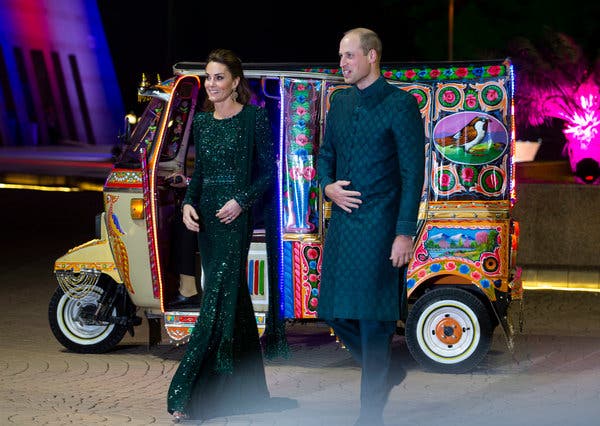In Pakistan, Kate Middleton Aces Fashion Diplomacy – The New York Times
Fashion Diplomacy With Kate and William
9 Photos
View Slide Show ›

So the Duke and Duchess of Cambridge (the British royal couple known more colloquially as William and Kate) have come to the end of their Pakistan tour, the first royal visit in 13 years. It has been, by all accounts, a highly successful five days of outreach. They met with Prime Minister Imran Khan! And schoolchildren! Played cricket! Saw many sights!
And reminded the world of how very effective fashion can be as a tool of diplomacy.
The rapturous summaries of their every move were matched only by the rapturous summaries of their every garment. It’s been a while since clothes were employed quite so strategically and consistently to send an unspoken, but also unmistakable, message. The effect was refreshing.

From the moment they stepped off the plane, the Duke and Duchess (O.K., mostly the Duchess, but he played his part too) signaled their intent to allow the quadrillion pictures taken of them to speak louder than the words they uttered mostly behind closed doors. Their clothes made silent statements cross-border respect, cultural awareness and outreach. No detail, or earring, was overlooked.
Witness the aquamarine-to-silver draped-neck dress by Catherine Walker with matching pants, a bridge between a tea dress and a shalwar kameez, which the Duchess wore to deplane at Nur Khan airbase on Monday.
Witness the periwinkle-blue shalwar kameez she wore on a visit to Margalla Hills, north of Islamabad, designed by Maheen Khan, who once dressed Benazir Bhutto, Pakistan’s former prime minister, as well as Jemima Khan, Prime Minister Khan’s ex-wife. (Ms. Bhutto’s wax figure at Madame Tussauds in London wears Ms. Khan’s design. Coincidence?)
Witness the jade-green A-line jacket by Ms. Walker worn over white pants by Ms. Khan, which the Duchess donned to meet the prime minister, an embroidered dupatta tossed over her shoulder.
Witness the emerald sequined Jenny Packham chosen for a reception at the Pakistan National Monument, which happened to be the green of the Pakistani flag, and which matched the sherwani, a traditional long coat, by the Pakistani designer Naushemian, worn by her husband.
(The couple has long been adept at color-coordinating their appearances for maximum image-making harmony.)
And there was more. So much more: earrings by Zeen, a Pakistani high street brand; another shalwar kameez by Gul Ahmed; a kurta by Élan Pakistan; a dupatta by Bonanza Satrangi; a coat from Beulah London. The clothes came at all price points and were often worn in concert: a little British style here, a little Pakistani there. The reaction was, almost entirely, ecstatic. Designers tweeted their excitement at being chosen. Observers applauded. Chroniclers of What Kate Wore went into overdrive.
Part of this, obviously, came from the boost given to local industry conferred by the Duke and Duchess, whose patronage can make national names known on the international stage. That’s always a welcome thing.
But a lot of it also indubitably comes from the fact that, after Melania Trump, whose intentions with her public clothing choices are often unclear; Ivanka Trump, who came under fire for wearing her own brand early in her father’s administration; and Meghan Markle, the Duchess of Sussex, whose clothes sometimes seems to advance her own agenda above all, it has become an increasingly rare expression of soft power.
Fashion, when it is employed not simply at the service of making someone look good, or morally upright, can have resonance far beyond the ritual. It’s about time someone remembered.
Let’s block ads! (Why?)

